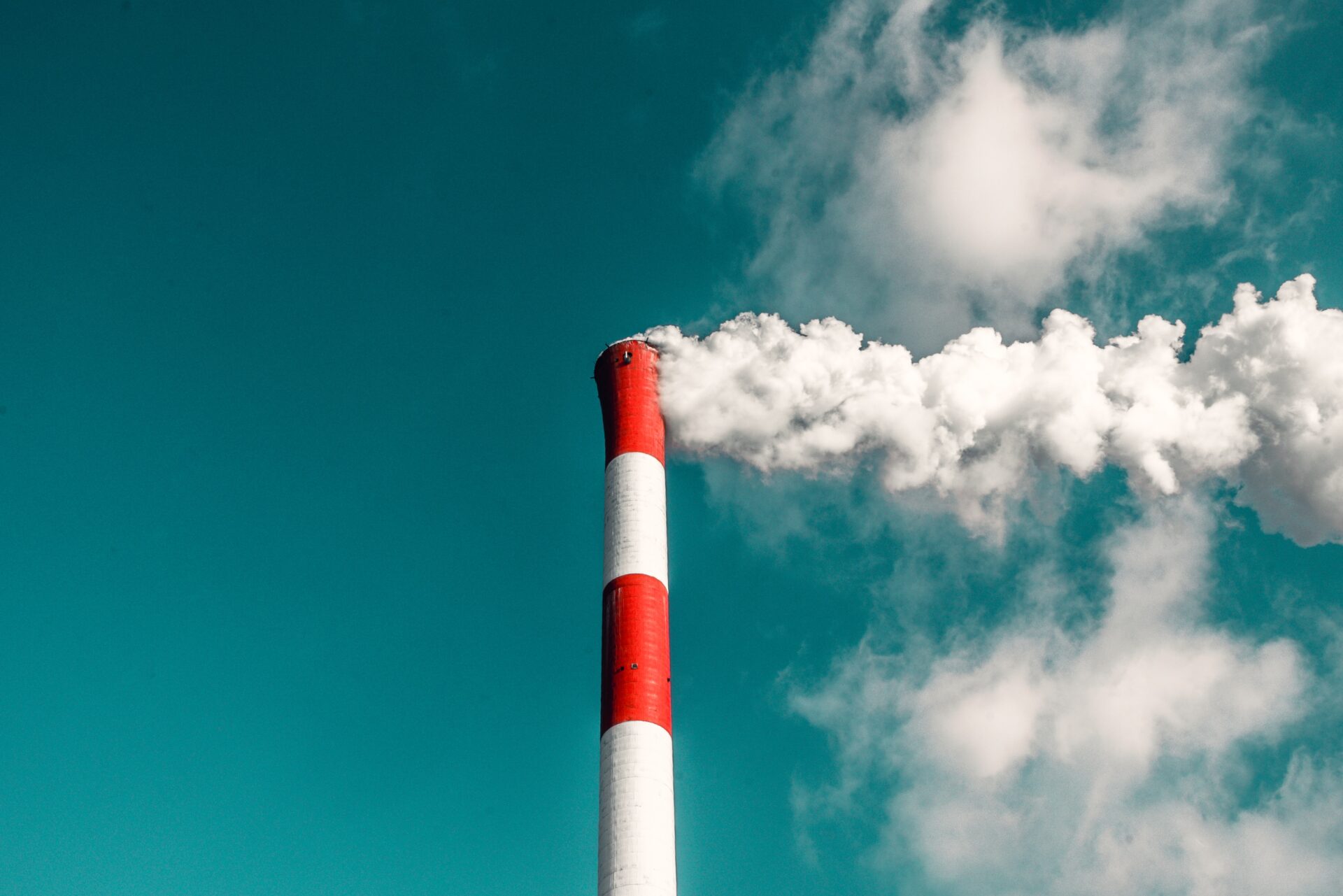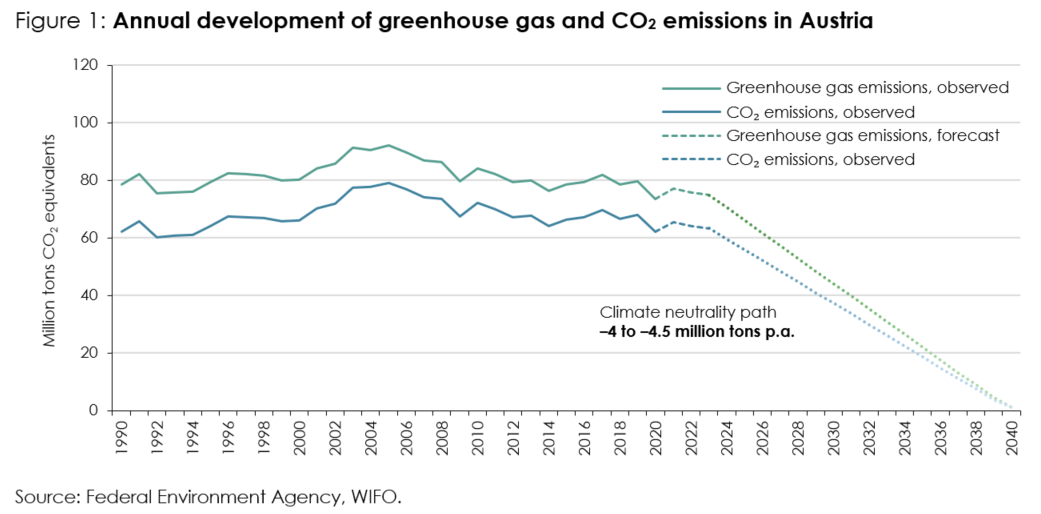
The Sharp Rise in Emissions in 2021 is Followed by a Slight Decline
Current analyses of monthly data indicate that greenhouse gas emissions in 2021 increased by slightly less than 5 percent in comparison to the previous year. Thus, they are expected to be only slightly below 1990 levels.
The positive economic outlook for 2022 (GDP +4.3 percent) is not reflected to the same extent in an increase in emissions as the less emission-intensive service sectors in particular are developing favourably and energy demand for heating could be lower than in the past winter. The weaker economy for 2023 suggests a slight decrease in emissions.
Well-being and a high quality of life are central goals of economic policy that have received too little attention in the past. This deficit is being addressed internationally with so-called "Beyond-GDP" indicators. "WIFO is the first economic research institute to integrate greenhouse gas emissions into its quarterly forecasting activities," says WIFO Director Gabriel Felbermayr. "This Beyond GDP indicator is central to understanding the interactions between the economy, the environment and safeguarding the quality of life on the one hand, and the influence of policies and shocks on the other, in a timely and accurate manner." Based on the Federal Environment Agency's greenhouse gas inventory, WIFO calculates Austria's greenhouse gas emissions from 2021 to 2023 as part of its economic forecast. The 2021 results are based on observed activities, while the values from 2022 onwards assume the current WIFO economic outlook on economic development and greenhouse gas intensity of sectors. These data are fed into the WIFO model "ALICE", which consistently depicts the interlinkages of energy, emissions and the economy.
The analysis of recent monthly data from 2021 in the areas of mobility, petroleum, electricity and gas consumption, and steel production indicate a strong increase in greenhouse gas emissions of slightly less than 5 percent compared to 2020. Thus, despite the high production utilisation of steel production (+17 percent) and the relatively cold course of the year (+12 percent heating degree days compared to 2020), the pre-crisis level of 2019 was undercut. In particular, the – partly lockdown-related – increase of only +4 percent in fuel sales explains this result, after 12 percent less fuel was sold in 2020 than in 2019.
To estimate the development of emissions in 2022 and 2023, the sectoral economic developments of industry and services are taken from the WIFO economic outlook and supplemented by trend updates, for example in the case of heating degree days or the further expansion of renewable energy sources. It was assumed that gas will not be replaced by coal as an energy source and that the utilisation of steel production capacities will decline in line with the economic cycle. High energy prices in 2022 and 2023 suggest that emission growth in the transportation sector will be muted. Discretionary measures to stabilise fuel prices in neighbouring countries (e.g., Germany, Hungary) make it difficult to estimate fuel exports in the tank, a significant item for greenhouse gas emissions.
The similar economic growth in 2021 and 2022 has very different effects on emission development. Whereas in 2021 a strong material goods economy was effective, associated with corresponding emissions, economic growth in 2022 is strongly influenced by the recovery of the less emissions-intensive tourism sector. This leads to an expected decrease in emissions of 1.8 percent in 2022. In 2023, it is primarily the overall lower economic growth explaining slightly declining emissions (–1,1 percent), with identified trends in e.g., energy intensity and heating degree days also contributing to this. "However, these estimated emission trends are not compatible with the reductions needed to achieve the set climate targets," says WIFO environmental economist Mark Sommer.
In order to achieve the climate targets, it is necessary to decouple the increase in value creation and employment targeted by economic policy from material consumption and climate-damaging greenhouse gas emissions. So far, this has only been achieved to a modest extent in Austria (Figure 1). The common goal of EU member countries to reduce greenhouse gas emissions by 55 percent by 2030 compared to 2005 and the goal of net greenhouse gas neutrality for 2040 defined in the government programme are ambitious, and can only be achieved with measures that have a short-term effect on the one hand and a structural effect on the other. "To ensure that these targets remain within reach, they must as soon as possible be broken down into intermediate temporal and sectoral targets and backed up with appropriate measures," emphasises WIFO environmental economist Claudia Kettner.

The thematic platform "Green Transformation and Energy Systems" bundles WIFO research work on these topics. One aspect of this work deals with the development, operationalisation and "nowcasting" or forecasting of indicators for sustainable development and prosperity.
The slides of the media chat are available here (in German).
Methodological notes
In the key figures on greenhouse gas emissions, a distinction is made between emissions of carbon dioxide (CO2) and non-CO2 emissions, which are understood to be greenhouse gases such as methane or nitrous oxide. Their atmospheric-warming effect is normalised to CO2 equivalents, the main greenhouse gas produced mainly by the combustion of fossil fuels.
The greenhouse gas forecast was prepared using the current WIFO economic outlook. The forecast is used in the WIFO model "ALICE". In this model, data on emissions, energy and the economy are consistently interlinked and time series analyses of data on greenhouse gas emissions (Federal Environment Agency), energy consumption, motor vehicle stocks, heating systems of private households, heating degree days (Statistics Austria), sales of petroleum products (WKO), electricity and gas volumes (e-control) as well as sectoral economic data and the WIFO economic outlook (WIFO-WDS) are integrated.
























